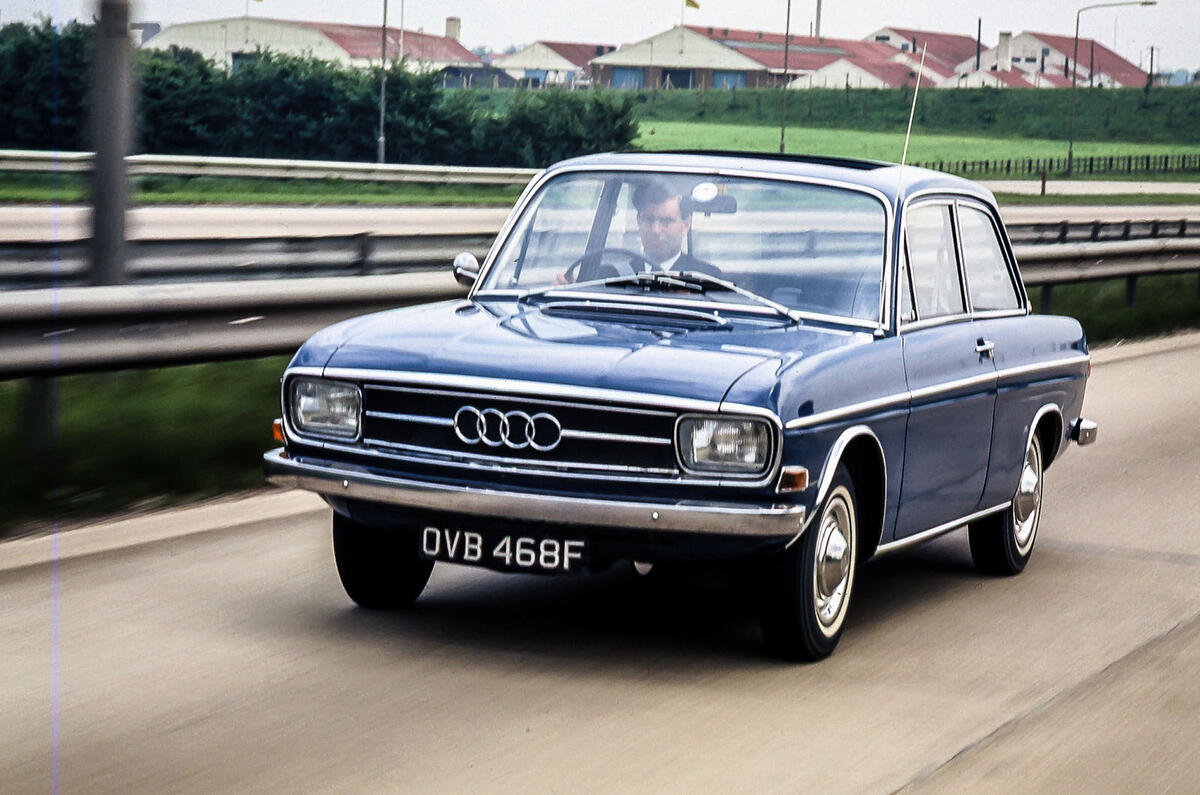During the mid-1960s, ownership of the Auto Union brand gradually shifted from Daimler to Volkswagen, which bought up shares and invested heavily in the Auto Union factory in Ingolstadt.
That plant was producing three-cylinder, two-stroke DKW models, but Volkswagen adopted a plan already put in place by Daimler to create a new family saloon around a 1696cc four-cylinder, four-stroke engine.
Although the saloon used most of the same underpinnings as DKW’s F102, VW wanted to tell the world that this was essentially a new car.
So Wolfsburg looked to the other manufacturer names that had originally comprised Auto Union, namely Audi, Horch and Wanderer. With Horch retained by Daimler and the Wanderer name presumably deemed not exactly ripe for revival, the new car was christened the Auto Union Audi, with ‘Audi’ as a model name rather than a make.
Autocar investigated the new car ahead of its 1966 debut. “Like the original Audi models and, of course, DKW ones as well, the new car features front-wheel drive with an all-synchromesh four-speed gearbox and inboard disc brakes at the front,” said Autocar. “The new engine has been designed and developed by Mercedes-Benz, tested and approved by Volkswagen and will be built by Auto Union.”
Setting a template for future Audis, the engine was “inclined at 40deg and mounted in front of the driven front wheels. A longer nose – the car has an front overhang of 872mm – overcomes the problem of fitting the engine in the front compartment.
“To keep the bonnet line low and particularly the centre of gravity, the engine is canted over at 40deg so that the induction side is on top.”
Intent on giving the Audi a better ride quality than its DKW sibling, Volkswagen focused on developing the suspension. “Double wishbones at the front are sprung by adjustable longitudinal torsion bars, and the telescopic dampers incorporate progressive rubber bump stops.
“Three reasons are given for the inboard brakes: they give less unsprung weight, to improve the suspension; they are not restricted in diameter by the wheel rim size; and there is a direct flow of cooling air through this part of the engine compartment.”
With its new, longer engine, the Audi was about four inches longer than the DKW F102, but otherwise the dimensions were much the same. There were rectangular headlamps and no mesh in the grille, just a surround and the four Auto Union linked rings, one for each of the original four companies.
“The body shell has a flat floor, since there is no propeller shaft, and there is room for five people,” said Autocar. “As the gearchange lever is on the steering column, there would be room for an additional front-seat passenger if separate seats were not fitted.”
After a 25-year absence, the Audi name was back, and its arrival was well timed. Sales of two-strokes were falling and the DKW brand associated with such units was phased out as the new Auto Union became available in 1966.
Previous Throwback Thursdays
4 March 1899 - Steam, electric or combustion engine?
26 June 1906 - The first French Grand Prix
9 July 1907 - The beginning of Brooklands
14 February 1913 - 100 miles in one hour
8 April 1916 - Making post-war predictions
25 March 1922 - Caterpillar tracks are the future
4 July 1925 - Citroën lights up the Eiffel Tower
2 February 1934 - The ethics of skidding
6 July 1934 - A tour of Cowley
1 June 1935 - Introduction of the driving test
22 June 1945 - Driving through post-WW2 Europe
21 January 1949 - Tidier tails
25 August 1950 - The evolution of transmissions
24 April 1959 - Aston Martin enters Formula 1
27 January 1961 - Ford Thunderbird road test
17 November 1961 - TVR Grantura road test
19 August 1966 - Four-wheel drive on test
6 May 1971 - Driving Ford's Supervan
12 June 1976 - Cars for under £100
10 July 1976 - Land's End to John O'Groats on one tank
13 May 1978 - Ferrari 512 BB road test
19 January 1980 - Talbot Horizon road test
13 February 1982 - 4x4s tested on the farm
17 April 1985 - Secrets of a lost British supercar
4 September 1985 - Ford's electronic test bed
15 August 1990 - Giugiaro's vision of a 1990s Jaguar
28 April 1993 - BL's unseen concepts
16 March 1994 - Bentley's Concept Java
16 April 1997 - When Bugatti bit the dust
4 April 2001 - 0-260mph in 6.0 seconds
25 July 2001 - 180mph in a Chevrolet Corvette
Get the latest car news, reviews and galleries from Autocar direct to your inbox every week. Enter your email address below:




Join the debate
Add your comment
If only...
Oo, get you.
Mercedes Budget Brand